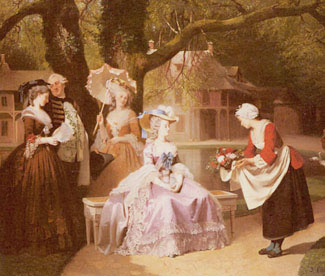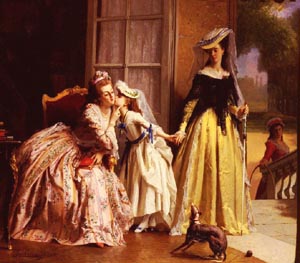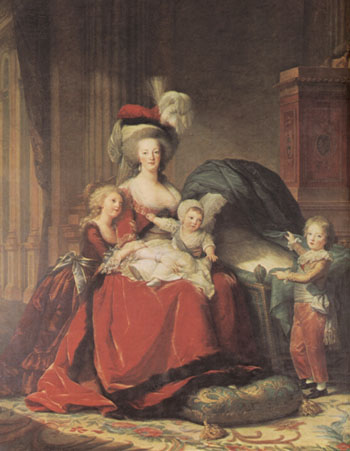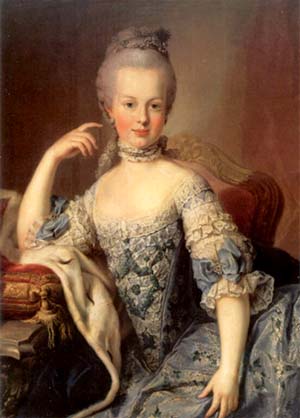 |
Book Reviews
Unmasking the Formidable Myth
about Queen Marie Antoinette
Marian T. Horvat, Ph.D.
Book-review on the work Trianon, A Novel of Royal France by Elena Maria Vidal
Long Prairie, MN: The Neumann Press, 2000, hardcover, 205 pp.
The topic was compassion. The place, a Catholic social journal. The tiresome historical error was repeated in the example the writer used to typify the opposite of compassion: “Marie-Antoinette, born and raised with an aristocrat’s unawareness of the plight of her indigent neighbors, suggested that the people ‘eat cake’ when informed that they had no bread.”
Yet another Catholic scholar entrapped by the revolutionary myths of history. For a long time I have been painfully aware of the pitfalls of the American Catholic history texts, filled with attitudes that blatantly or unconsciously celebrate Liberty, Equality, and Fraternity, the Trilogy of the French Revolution condemned by the Church and Popes (1).
Time and time again, American history books, even the “old” Catholic textbooks, make Marie-Antoinette (1755-1793) the scapegoat to justify the horrors and excesses of the French Revolution, which, after all, was only a more radical French version of our own American Revolution that “liberated” the people from the evils of monarchy.
Therefore, it follows that the Queen’s greed, frivolous excesses and total disregard for the little people would have fed the flames of the revolt of the people against the monarchy. However, this is not true. There is a sophism hidden in this myth.
The real Marie Antoinette was generous hearted
In fact, it was because Marie Antoinette was aristocratic, generous-hearted, and courageous that she became the target of the lies and defamation campaigns of the revolutionaries (2). The false image of the frivolous heartless Queen bent only on amusing herself and satisfying her whims and passions was artificially created for posterity and included in history books, with the aim of etching this image into young malleable minds. Such a process leaves deep, long-lived impressions, difficult to erase.

A peasant presents flowers to the Queen at Trianon | |
For the facts on all points in this case are quite the opposite. The French Revolution, as with many succeeding revolutions, did not rise spontaneously from the discontent of the people. Its ideas were born from the Enlightenment thinking that circulated in the Masonic lodges, spread through the societés de pensée. From there these new exciting notions infiltrated the conversation salons and to the multifarious semi-secret clubs, so numerous in that epoch. Their perpetrators desired the destruction of the sacred hierarchy of both Church and State in their hatred for the remnant order of the Age of Faith.
The real Marie Antoinette did not despise the people. To the contrary, the Queen of France had a compassionate, generous-hearted spirit and a genuine feminine concern for the plight of the poor. It was well known at the court that it was only necessary to reach the ear of the Queen with a tale of financial misfortune or personal misery to receive a pension, dowry or alleviation for the woe. At the beginning of her reign, she relieved the people of the tax known as “the Queen’s belt” with the remark “Belts are no longer worn.” However, it is not this quip that has survived as legacy for posterity.
Because of most of the deplorable literature - that has permeated English-speaking ambiences and served to perpetuate the false myths and lies about the French Revolution, it has long been my hope to see a book for young adults which would help to destroy these revolutionary germs in their first stages of development: A book that would present an accurate picture of the heroic Queen. A book was needed that would underscore Marie-Antoinette’s admirable qualities, so that the young people of the future would not imbibe the same prejudices against the French Monarchy swallowed unthinkingly by the generations before them.
A book that breaks the myth
Recently I came across such a book that certainly will begin to fill this lacuna. Trianon is a short but compelling piece of historical fiction written by Elena Marie Vidal. In her preface, the author tells the readers that this is the story “of the martyred King Louis XVI and his Queen.
The fruit of years of research, the book attempts to correct many of the popular misconceptions of the royal couple, which secular and modern historians have tried so hard to promote. Louis and Antoinette can only be truly understood in view of the Catholic teachings to which they adhered and within the context of the Sacrament of Matrimony. It was the graces of this sacramental life that gave them the strength to remain loyal to the Church, and to each other, in the face of crushing disappointments, innumerable humiliations, personal and national tragedy, and death itself.”
Author Elena Vidal made use of a charming device to tell the true story. Each chapter is viewed through the eyes of one of the key players in the life of the Royal Family, e.g.:
- Madame Louise, the Carmelite aunt of King Louis XVI who counseled the King to dedicate France to the Sacred Heart;
- the King’s saintly youngest sister, Madame Elizabeth of France, who wanted to enter Carmel but remained at Court at her brother’s request to exert her good influence on the Queen and court;
- the Irish confessor of the King, Abbé Edgeworth de Firmont, who was privileged to witness Louis XVI’s last moments. It was his voice that cried out after the blade fell: “Ascend to heaven, son of St. Louis!”
- Rosalie, the young maid who served the Queen faithfully in her last days and reported the great courage and fidelity to the Faith of Marie-Antoinette: her refusal to accept confession from the revolutionary priest who had sworn the oath of the Civil Constitution, her calm and assured bearing to the end., when she was driven to her execution in an oxcart in the same manner of common criminals.
Finally, the author enters boldly into even the minds and imaginations of the King and Queen, whose human defects and frailties were purified, as gold by fire, by the humiliations and great trials they suffered at the hands of the revolutionaries. By the time of his trial and execution, King Louis XVI, a man who himself admitted he was scourged with weakness and irresolution, had assumed firm and courageous attitudes.

A fond kiss for the Queen from Madame Royale during happy days at Trianon | |
In her Memoires, his daughter Marie-Thérèse-Charlotte of France (Madame Royale), the only member of the Royal family who would escape death at the hands of the Revolution, described her father’s conduct at his trial before the Convention in December of 1792 as something “all the world knows – his firmness, his gentleness and kindness, his courage amid assassins thirsting for his blood, traits which will never be forgotten and which the most remote posterity will admire” (3).
The daughter’s portrayal of her mother, for whom she had the greatest love and unrestricted admiration, presents the true face of the martyred Queen, the Marie-Antoinette who had matured into a loyal, dedicated wife and mother with unparalleled courage. One scene in particular from Madame Royale’s “Memoires” remains forever etched in my memory. It was the day the revolutionaries marched on Versailles, October 6, 1789. Bread was scarce in Paris, “the people” were starving and the rumors had been spread that flour was being hoarded at Versailles. Some of the ruffians rushed the guards and stormed the King’s staircase . Entering the royal chambers, they stabbed the Queen’s bed with their pikes. The rabble continued its cry: “We want the Queen! We will cut off her head, fry her liver, and that won’t be the end of it.” It seemed that the only thing that would calm the people would be for the Queen to show herself.
To spare the danger threatening her husband and children, she chose to appeared before the riled mobs. She stood before them, her expression noble, her countenance serene without the slightest sign of alarm. This great spirit and courage, which always characterized the Queen, silenced the crowd. For the moment the situation was saved. "I later learned that one of the conspirators aimed his firing-piece at her, but could not dare to complete his crime.” Madame Royale recounted.
The revolutionaries then compelled the Royal family to return to Paris. Drunken men and women ran alongside the carriage shouting obscenities and insults until they reached the Tuilleries where they became prisoners of state. The sun finally fell on that horrendous day, which no words could adequately describe. And then, Madame Royale recounted, my mother said something very strange to my father: “It is tribulation that first makes one realize what one is” (4).
It was certainly the great trials and horrors of the days ahead that served to show who and what Louis XVI and Marie Antoinette really were. It is to Maria Elena Vidal’s credit that she succeeds in portraying their fortitude and fidelity to the Church, their nation, family and each other. Her work is “historical fiction,” but after reading it, one will begins to understand the real evil and hatred of the French Revolution for all that was good and virtuous, and its despisal for all that was aristocratic, noble and hierarchical, that is to say, Catholic. It is no wonder that this hatred and scorn focused on Louis XVI and Marie Antoinette, who embodied in their very persons and beings these qualities. This is a book I would add to every Catholic high-school curriculum as must reading on the history of the French Revolution.
An eulogy to a much-maligned Queen
It is impossible to end this commentary without a few words to honor one of the most maligned and wronged queens in History. This is the Queen reputed to have the most exquisite translucent complexion in all Europe, painted often in the celebrated portraits of court favorite Madame Elisabeth Vigée-Lebrun. This is the Queen who entered a room and filled it with her presence, whose grace and charm of movement distinguished her immediately in a group and identified her as Marie-Antoinette, Queen of France.

The Queen and her family | |
The charm of the youngest daughter of Holy Roman Emperor Francis Stephen and Empress Maria Teresa was a special gift from her father’s lineage, the house of Lorraine. The people of Lorraine are famed for a certain charisma to attract and charm. A first example: the Maid of Lorraine, St. Joan of Arc, whose very name inspires a certain awe. This is the result not only of her fidelity to her supernatural vocation, but also the personal charm and charisma that the words and actions of the Virgin of Lorraine transmits until today.
Another example: Mary Stewart, Queen of Scots (1542-1587), the red-haired spirited beauty who at age 16 married the French Dauphin, who briefly became king before his death in 1560. During her sojourn in France, she perfumed the French court with her charm and grace, leaving a fragrance that lingered long after her return to Scotland in 1560. It was no doubt in fear of the force of this peculiar charm that could impel her countrymen to follow her and restore her to the Crown that Elizabeth I confined Mary for 18 years and finally had her tried for treason and executed in February 1587.
Another instance of this very curious Lorraine gift can be seen in the Guise family from the House of Lorraine. Three men and a women, Henry of Guise, the Cardinal of Lorraine, the Duke of Mayence, and the Duchess of Montpensier, became the embodiment of the spirit of the Counter-Reformation in Catholic France of that time. This leadership extended beyond the battle lines; their followers were literally charmed by the family. At that time, there was a serious debate as to what family would succeed to the Crown of France and the decadent House of Valois: the Catholic line of Guise or the Protestant Bourbon family. It was necessary to murder Henri de Guise to make Henri de Navarre the first Bourbon king.
A swan in a lake of glory
This same Lorraine charm was inherited by Marie Antoinette. Her “goodness, affability and gaiety” charmed the Abbé de Vermond who came to Vienna to prepare the young Archduchess for the role that she had to play in France. At her touching farewell to her mother in 1770, the discerning Empress counseled her: “You have the gift of pleasing others; use it for the happiness of your husband.” Her simple childlike charm won the heart of aging King Louis XV and earned a delirious reception from the people upon her entry into France when the fountains of Paris literally flowed with wine. It was a fairy-tale wedding that “dazzled the eye and astonished the mind” with the most magnificent firework displays ever seen at Versailles.
She also won the devotion and love of her husband. Later, Louis XVI, would grieve more for her sufferings and deprivations in their imprisonment than for his own. “Who would have foreseen,” he mourned, that in uniting your lot to mine, you would have descended so low?” The Queen replied: “And do you esteem as nothing the glory of being the wife of the best and most persecuted of men? Are not such misfortunes the noblest honors?”

Elegant and charming, the real Marie Antoinette
|
She inspired the devotion of friends who followed her even to death. Princess of Lamballe, one of Queen’s most intimate friends, had been safely out of the country at the start of the French Revolution, but she returned from England to be with her sovereign in her bad moments. “One who shared in the joys of so good a Queen should also share in her sorrows,” she responded to the Queen’s entreaties for her to escape.
Such was the charm and majesty of this Queen, a majesty that shone with special brightness in the tragic events of the French Revolution. It was her majesty that dominated at the end of a life that closed prematurely as she climbed the steps of the scaffold to be executed. To the end, she maintained a dignified bearing and showed no fear.
This was a Queen so great that even though she was Austrian, she was able to synthesize the French soul and became a model of France. When one thinks of a French king, one immediately recalls Louis XIV, the Sun King who shined not only on France but over all of Europe in the 17th century. When one thinks of a French queen, one recalls Marie Antoinette. The revolutionaries did all in their power to destroy her reputation and soil her image. They even succeeded in executing her. But her elegant figure - her stately form, her alabaster long neck supporting a majestic head with its classical powered coiffure - remains as a model moving in a world of dreams, a swan among humankind swimming gracefully in a lake of glory.
1. For example, Pius VI condemned the “omnifarious liberty and absolute equality” established by the Civil Constitution of the Clergy as “foolish and even monstrous concepts” in his Decretal of March 10, 1791 and his Encyclical Inscrutabile Divinae Sapientiae of December 25, 1775. See also: Pius IX, Encyclical Nostris et nobiscum of Dec. 9, 1949; Leo XIII’s Encyclical Humanum genus against Freemasonry of April 20, 1884; St. Pius X’s Notre charge apostolique of August 25, 1910; Benedict’s XV’s Allocution of July 11, 1920, apud Plinio Corrêa de Oliveira, Nobility and the Analogous Traditional Elites (Hamilton Press, 1993) Appendix III, pp. 382-89.
2. A surprisingly frank and honest academic work that exposes the lies, deceits and horrors of the French Revolution is Simon Schama’s Citizens: a Chronicle of the French Revolution (New York: Alfred A. Knopf, 1989). While modern historians have steered clear of anything that could be construed as subscribing to the literary conspiracy theory of the French Revolution, Schama reported how the revolutionary ferment was nourished by “pornographic libels, vitriolic satire and radical political theory” (p. 176). The deconstruction of Marie Antoinette’s image was a pathetic thing: the Marie Antoinette of the libelles[scandal sheets] was a sexual monster, a vindictive harpy, and political spy for Austria (pp.220-226).
3. Elizabeth Powers, The Journal of Madame Royale (New York: Walker & Co., 1976), p. 94.
4. Ibid., pp. 26-31


Related Topics of Interest
 Louise of France and Her Counter-Revolutionary Action Louise of France and Her Counter-Revolutionary Action
 Madame Royale Innocence Madame Royale Innocence
 Nobility and Accessibility: Keys of Catholic Charity Nobility Nobility and Accessibility: Keys of Catholic Charity Nobility
 The Personality of Charlemagne The Personality of Charlemagne
 Revolution and Counter-Revolution - Overview Revolution and Counter-Revolution - Overview

|
Book Reviews | Home | Books | CDs | Search | Contact Us | Donate

© 2002-
Tradition in Action, Inc. All Rights Reserved
|
 |
|